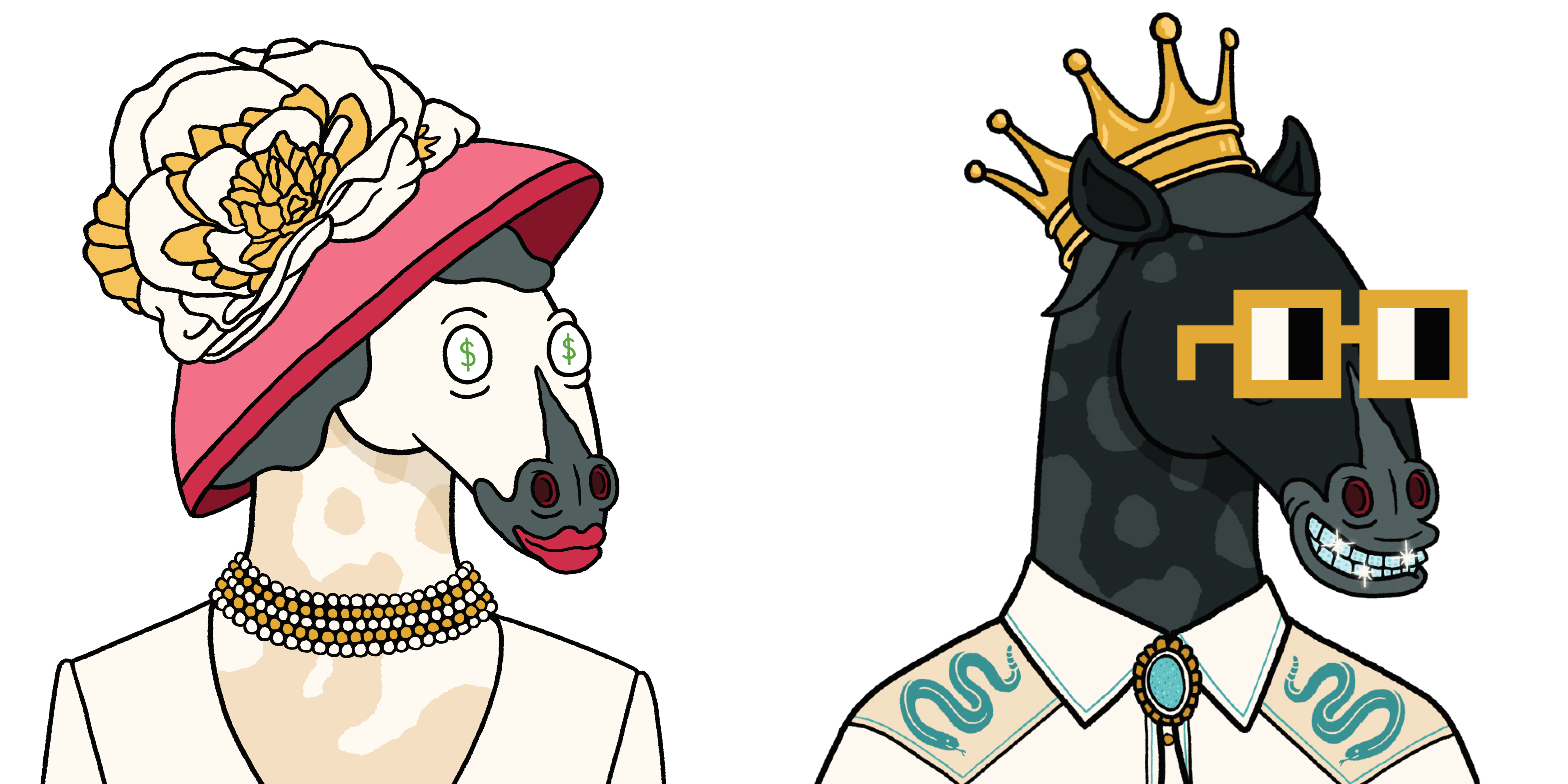“We want to create an NFT that creates value for society as well as its holders.” CEO Justin Delaney shares his mission for philanthropic NFT project Party Horses.
Despite the colossal buzz surrounding NFTs and the rising community of new-age ‘digital art collectors,’ it can be quite the task to find a project that resonates with both art lovers and NFT enthusiasts alike.
Enter Party Horses, a recently developed NFT project founded by Justin Delaney and Brook Smith.
The project consists of digital images of cartoon horses on the blockchain, bringing ‘Kentucky Derby’ culture to Web3. Those who purchase the NFTs (must be 21 or older) will be able to access products like a Bourbon made in collaboration with Maker’s Mark, as well as events like an exclusive concert featuring artists like Diplo and DJ Irie.
The Party Horses team tapped model Helena Christensen and designer Camilla Stærk in an attempt to increase women’s representation in the male-dominated Web3 field. Each season, Party Horses will support four to six organizations that will receive 15% of its royalties. In the future, it aims to consult its community to determine which charities the royalties are donated to.
Below, Mission Magazine speaks with Party Horses CEO Justin Delaney about his primary goal for the project, his creative inspiration, and how the project will contribute to the development of Web3.
Symeon Oshea: What is the Party Horses project’s primary mission?
Justin Delaney: Our primary goal is to take NFTs and create a framework where they make more economic sense in conventional value terms. We are striving to create an NFT project that encompasses four pillars: philanthropy, community, brands, and events. We want to make an NFT that creates value for society as well as its holders.
SO: What was the creative inspiration for Party Horses?
JD: What if the horses went to the Derby to watch the human race as opposed to vice versa. What if you flipped the script? What if the roles were reversed? Tradition shifted, but the speed remained. Ah, what if that was the design prompt for our art. There would be horses in top hats, watching from the trillionaires row.
SO: For those who may not know, what is the difference between a regular NFT and a generative NFT?
JD: A generative NFT is created by an artist and developer. Our artist, Robby Davis, designed all 1000 potential attributes for 10,000 Party Horses (hats, shirts, etc.) And our developer, Izaak Prats, created a generative code to randomly assign those attributes to each horse. Each trait has some level of statistical rarity.
SO: How will this project contribute to the current development of Web3?
JD: Party Horses is at the forefront of mixing web3 tech with real-world applications. Our collaboration with Maker’s Mark is the first major Independent NFT and Spirits brand collaboration. We want to bring web3 into the world of philanthropy, events, and brand partnerships.
SO: Why is equal representation so crucial within the NFT space?
JD: Equal representation is vital in every field, including NFTs. It is impossible to properly empathize at a societal level and create without a diversified perspective.
SO: How were you introduced to NFTs, and what made you want to create a project in the NFT realm?
JD: One of my friends, Jeremy Booth, created an NFT project called Bushidos. I admired the mixture of worlds that he made with art and technology. That was the first project that pulled me in. I also collect Japanese woodblock prints, and I love the democratization of art and access that artists like Hiroshige created with their art by doing it in a serial woodblock style. NFTs remind me of a modern version of woodblock prints—a spiritual offspring of that old technology.
SO: What benefits can NFT holders and community members expect?
JD: We plan to create a mixture of brand collaborations, events, and philanthropic giving on a seasonal basis. For example, for season one, we are partnering with Maker’s Mark and throwing a party during Kentucky Derby weekend in Louisville, Kentucky. We will leverage the brand to create rare access and products only available to our community members—just like our limited edition Party Horses X Maker’s Mark bourbon. On the philanthropic side, we have formed partnerships with VetPaw, Free Arts NYC, Appalachian Impact Fund, Backside Learning Center, and LexArts. These charities will receive 15% of royalty revenue. Our community will vote on philanthropies each season.
SO: How did the Philanthropy element come into play?
JD: We established very early on that we did not create this NFT project with any financial goals. This is a creative pursuit, sort of a social experiment. We wanted to mix four primary ingredients: philanthropy, community, brands, and events. It felt too esoteric and aimless to do it in broad-stroke, so we chose Party Horses as the vessel for our intent. The philanthropic component is the primary piece because every organization needs to think first and foremost about how they intend to make the world a better place than they found it.
SO: What organizations are you supporting and why?
JD: We chose organizations that touch on our passions: art, animals, veterans, learning, and the Appalachian region. Long term, we want our community to determine who Party Horses will support.
SO: In what ways do you see this project evolving as it moves forward?
JD: That’s a surprise, but we are very ambitious and are excited to create a meaningful brand that creates connections and does a lot of good.
Images courtesy of Party Horses





